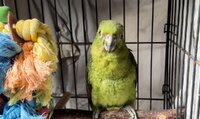SkyDancer
Meeting neighbors
Hi everyone,
We decided to welcome home a little YNA. He was born April 2nd, making him around 14 weeks.
Breeder said he was starting to eat solids but he was still giving him formula 2x a day in a syringe.
I used to be a Vet Tech for an avian vet and handfed a lot of parrots (she was also a breeder).
We picked him up last night and I mixed up his formula but he showed no interest. I am used to them bobbing their heads and taking it pretty quickly. He kind of nibbled on the syringe and lapped at it with his tongue for a minute. He maybe ate 2.5ccs? Then shook his head and had a couple tiny bubbles it seemed by his nostrils/nares. I have a hard time believing he inhaled any when it was such a small amount and he swallowed it - but he just generally doesn’t seem interested.
Can I put it on a spoon or in a bowl instead? I made some scrambled eggs which he was excited about and nibbled at!
I do have a scale and will be weighing him. Also, suggestions on housing?
They can’t go in a regular cage at this point as they could fall, right? We have a huge corner cage that will eventually be his.
I have him set up in a small wire kennel with low perches, bowls, and a rope toy now! Should I leave water and food in the cage with him? I am worried about him dipping his whole beak in and getting it in his nares.
We decided to welcome home a little YNA. He was born April 2nd, making him around 14 weeks.
Breeder said he was starting to eat solids but he was still giving him formula 2x a day in a syringe.
I used to be a Vet Tech for an avian vet and handfed a lot of parrots (she was also a breeder).
We picked him up last night and I mixed up his formula but he showed no interest. I am used to them bobbing their heads and taking it pretty quickly. He kind of nibbled on the syringe and lapped at it with his tongue for a minute. He maybe ate 2.5ccs? Then shook his head and had a couple tiny bubbles it seemed by his nostrils/nares. I have a hard time believing he inhaled any when it was such a small amount and he swallowed it - but he just generally doesn’t seem interested.
Can I put it on a spoon or in a bowl instead? I made some scrambled eggs which he was excited about and nibbled at!
I do have a scale and will be weighing him. Also, suggestions on housing?
They can’t go in a regular cage at this point as they could fall, right? We have a huge corner cage that will eventually be his.
I have him set up in a small wire kennel with low perches, bowls, and a rope toy now! Should I leave water and food in the cage with him? I am worried about him dipping his whole beak in and getting it in his nares.
Attachments
-
130.9 KB Views: 15


